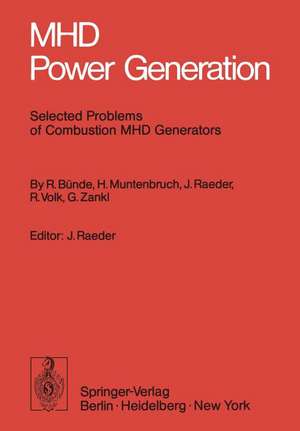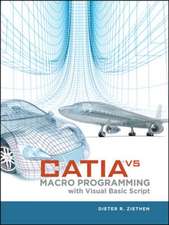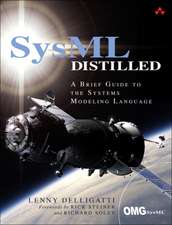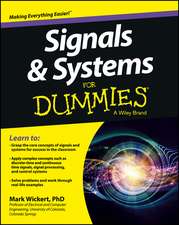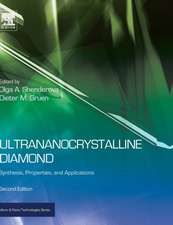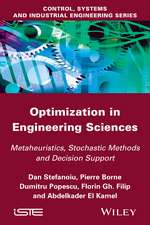MHD Power Generation: Selected Problems of Combustion MHD Generators
Autor R. Bünde Editat de J. Raeder Autor H. Muntenbruch, R. Volk, G. Zanklen Limba Engleză Paperback – 30 sep 1975
Preț: 641.03 lei
Preț vechi: 754.15 lei
-15% Nou
Puncte Express: 962
Preț estimativ în valută:
122.68€ • 127.60$ • 101.28£
122.68€ • 127.60$ • 101.28£
Carte tipărită la comandă
Livrare economică 15-29 aprilie
Preluare comenzi: 021 569.72.76
Specificații
ISBN-13: 9783540072966
ISBN-10: 3540072969
Pagini: 272
Ilustrații: XII, 258 p.
Dimensiuni: 170 x 244 x 14 mm
Greutate: 0.44 kg
Ediția:Softcover reprint of the original 1st ed. 1975
Editura: Springer Berlin, Heidelberg
Colecția Springer
Locul publicării:Berlin, Heidelberg, Germany
ISBN-10: 3540072969
Pagini: 272
Ilustrații: XII, 258 p.
Dimensiuni: 170 x 244 x 14 mm
Greutate: 0.44 kg
Ediția:Softcover reprint of the original 1st ed. 1975
Editura: Springer Berlin, Heidelberg
Colecția Springer
Locul publicării:Berlin, Heidelberg, Germany
Public țintă
ResearchDescriere
This book was planned and drafted even before the oil crisis at the end of 1973 drama tically highlighted the importance of research in the field of power production. This turn of events has by no means detracted from the value of the material presented. On the contrary, research on the rational exploitation of energy resources has gained in importance. The development of MHD generators is one of the fields which, it is hoped, will make an important contribution. It is nowadays no longer sufficient, however, just to perform good work. The national treasury, i.e. the taxpayer, allocates considerable funds for scientific research, and the public is therefore entitled to a reasonable account of the results achieved in R&D work. A monograph such as this seems to be the most suitable vehicle for the purpose. Furthermore, in keeping with modern research a group from Max-Planck-Institut fur Plasmaphysik combined with a group from a major industrial company, Maschinen fabrik Augsburg-Ntirnberg AG (M.A.N.), to launch a joint project. The close coopera tion between research establishments and industry will doubtless be intensified.
Cuprins
1. Introduction.- 2. Theory.- 2.1. Basic flow equations of an electrically conducting gas.- 2.1.1. The general equations of magnetogasdynamics.- 2.1.2. Ohm’s law.- 2.1.3. One-dimenstional flow equations.- 2.1.3.1. Definition of the fluxes of mass, momentum, and enthalpy.- 2.1.3.2. Axial variations of the fluxes.- 2.1.3.3. Explicit formulae for the mean values.- 2.1.3.4. The one-dimensional flow equations.- 2.1.3.5. Simple relations between mean and axial values.- 2.1.4. A “mean” Ohm’s law.- 2.2. Calculation of the material functions.- 2.2.1. Determination of the plasma composition.- 2.2.1.1. General remarks.- 2.2.1.2. Equilibrium constant method for a mixture of ideal gases.- 2.2.1.3. Definitions concerning the composition of the fuel-oxidizer mixture before combustion.- 2.2.2. Calculation of the thermodynamic functions.- 2.2.3. Calculation of the combustion temperature.- 2.2.4. Calculation of the electrical conductivity.- 2.2.4.1. Electrical conductivity of a very weakly ionized plasma.- 2.2.4.2. Electrical conductivity in terms of mean collision cross-sections.- 2.2.4.3. Electrical conductivity in the Frost approximation.- 2.2.5. Calculation of viscosity and thermal conductivity.- 2.3. Data and material function pertaining to typical potassium-seeded combustion plasmas.- 2.3.1. Reaction equations and energies.- 2.3.2. Zero temperature enthalpies H0i.- 2.3.3. Collision cross-sections for momentum transfer between electrons and heavy particles.- 2.3.4. Special numerical results.- 2.3.4.1. Mole fractions, thermodynamic functions, Mollier charts, combustion temperatures.- 2.3.4.2. Viscosities, thermal conductivities, and Prandtl numbers.- 2.3.4.3. Electrical conductivities and collision frequencies.- 2.4. Treatment of the boundary layers.- 2.4.1. Transition from laminar to turbulent flow.- 2.4.2. Boundary layer profiles of vx and T for turbulent gasdynamic plate flow.- 2.4.3. The “fine structure” of the turbulent gasdynamic boundary layer close to the wall.- 2.4.4. Calculation of the wall shear stress ?w.- 2.4.5. Calculation of the wall heat losses.- 2.4.6. Calculation of various “deficiency thicknesses”.- 2.4.7. Influence of variable free-stream velocity on the boundary layers.- 2.4.8. Influence of the wall roughness.- 2.4.9. The effective electrode voltage drop Ue.- 2.4.10. Influence of MHD effects on the boundary layers.- 3. Design of MHD generator systems.- 3.1. Estimate of the influence of the combustion efficiency on the electric output power.- 3.2. Numerical calculation of the MHD generator.- 3.2.1. Combustion calculation.- 3.2.2. Calculation of the expansion in the combustion chamber and Laval nozzle.- 3.2.3. Calculation of the flow in the MHD duct.- 3.2.3.1. Numerical solution of the system of equations.- 3.2.3.2. Integral error check and accuracy.- 3.2.3.3. Representation of the results.- 3.3. Design criteria and boundary conditions.- 3.4. Calculation of power production costs.- 3.4.1. Installation costs.- 3.4.1.1. Combustion system.- 3.4.1.2. MHD generator duct.- 3.4.1.3. Superconducting magnet.- 3.4.1.4. Inverter system.- 3.4.1.5. Exhaust gas system.- 3.4.1.6. Power plant buildings and equipment.- 3.4.2. Total power production costs.- 3.5. Influence of the design parameters on operational safety and power production costs.- 3.5.1. Influence of duct divergence.- 3.5.2. Influence of the angle of inclination of the equipotential surfaces in the duct.- 3.5.3. Influence of Mach number at duct entrance.- 3.5.4. Influence of magnetic induction.- 3.5.5. Influence of the lenths of the duct and magnetic field.- 3.6. Design for minimum power costs.- 4. Technical problems.- 4.1. Combustion systems.- 4.1.1. Basic remarks.- 4.1.2. Propellants.- 4.1.2.1. Solid fuel — solid oxidizer.- 4.1.2.2. Hybrid systems.- 4.1.2.3. Liquid fuel — liquid oxidizer.- 4.1.2.4. Liquid-gaseous and gaseous-gaseous systems.- 4.1.2.5. Seed material feed.- 4.1.3. Combustor design.- 4.1.4. Nozzle design.- 4.1.5. Supply system.- 4.1.6. Testing of combustion system.- 4.2. MHD ducts.- 4.2.1. Operating principle: Faraday, Hall or slant-wall duct.- 4.2.2. Design principle: Cold, warm or hot duct.- 4.2.3. Design features of the duct.- 4.2.3.1. Breakdown strength of duct walls.- 4.2.3.2. Expansion of duct due to heating.- 4.2.3.3. Wall thickness of MHD ducts.- 4.2.3.4. Problem of current collectors.- 4.2.3.5. Vibration testing of MHD ducts.- 4.3. MHD Magnets.- 4.3.1. Conditions.- 4.3.2. Choice of conductors.- 4.3.3. Winding geometry and concept.- 4.3.4. Iron shielding.- 4.3.5. Magnetic field and force distributions.- 4.3.6. Design.- 4.3.7. Quench behaviour.- 4.3.8. Heat losses and refrigeration system.- 4.3.9. Electrical system.- 4.3.10. Conclusions.- 4.4. Other components.- 4.4.1. Diffusor and exhaust system.- 4.4.2. Inverter system.- 5. Experimental investigations.- 5.1. Test rig.- 5.1.1. Combustion system.- 5.1.2. MHD ducts.- 5.1.3. Saddle coil magnet.- 5.1.4. Extraction of exhaust gas.- 5.1.5. Data acquisition.- 5.2. Measuring methods and problems.- 5.2.1. General remarks.- 5.2.2. Pressure.- 5.2.3. Gas temperature.- 5.2.4. Heat flux into the duct wall.- 5.2.5. Velocity of flow.- 5.2.6. Electrical conductivity.- 5.3. Experimental results.- 5.3.1. Parameters governing the values of the flow variables at the duct entrance.- 5.3.1.1. Seed ratio.- 5.3.1.2. Oxygen-fuel ratio.- 5.3.1.3. Combustion chamber pressure.- 5.3.1.4. Combustion efficiency.- 5.3.2. Boundary layer effects in the duct.- 5.3.3. Flow parameters and electrical conductivity along the duct without MHD interaction.- 5.3.4. Flow parameters in the duct with MHD interaction.- 5.3.5. Electrical properties of the MHD generator.- 5.3.6. Short-circuit effects.- 5.3.7. Discussion of electrode voltage drop.- 5.3.8. The influence of the combustion efficiency on the generator performance.- 5.3.9. Fluctuations.- 6. Application of fuel-oxygen fired MHD generators.- 6.1. Characteristic properties of the MHD generator.- 6.2. Power generation costs.- 6.2.1. Assumptions.- 6.2.2. Costs of installation.- 6.2.3. Total power production costs.- 6.3. The MHD generator as a reserve unit.- 6.3.1. Some remarks on reserve power supply.- 6.3.2. Existing possibilities of providing short-period reserve power.- 6.3.3. Provision of reserve power with the MHD generator.- 6.4. The MHD generator as emergency power supply for nuclear power stations.- 6.5. The MHD generator for powering plasma experiments.- 6.5.1. The power requirements of large plasma experiments.- 6.5.2. The applicability of the MHD generator.- 7. Concluding Remarks.- 8. References.
